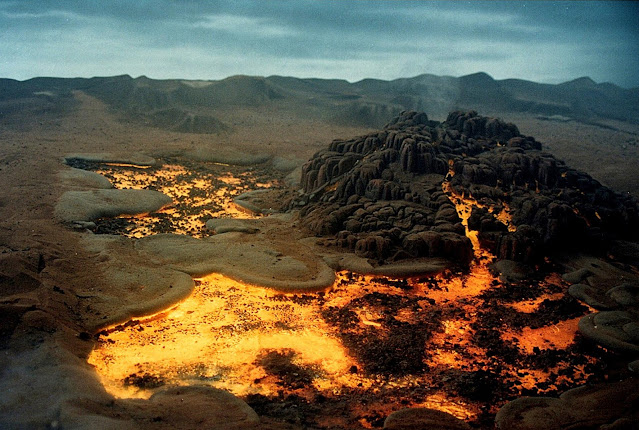One Ultraman episode was filmed at an RAAF Air force base and we had to match the hangar in miniature. It was also a further outing for our contingent of FA18 models in 1/48 and 1/32 scale.
Miniature
aircraft Hangar model 1/48 scale FA18 models parked out the
front with the UF-O creature hovering above. In the background is a
warehouse model built for a previous episode with no roof. The lack of
roof was not visible from the low camera angle. Unfortunately I can't
recall who built the hangar model.

In
the episode the UF-O creature breaks out of the hangar by punching
through the roof. The bent out roof panels were made from the same thick
aluminium foil known as "fin stock" as used for the blasted rock walls
of the under ground UMA base. The aluminium panels were pressed between
two Evergreen textured styrene sheets to impart the same corrugations as
on the rest of the model.

Here
I am attempting to superglue the Evergreen styrene roof panels down
which expanded and buckled under the heat of the studio lights. The
foreground FA18 model is 1/32 scale with the 1/48 scale models behind.

Of
course the UF-O creature causes havoc. One of the 1/32 scale models is
trashed. Pyro effects were by Alan Maxwell assisted by Judy Dabbs.

The
aftermath of the explosion. You can see the specks of black soot on the
foreground aircraft model that would pepper everything in the vicinity
of the pyro. It would all have to be cleaned off for use in another
shot. Models tended to get dirtier and dirtier as the model shoot
progressed.

A
second 1/32 scale model about to take one for the team. You can see
that the model has been pre-broken and loosely put back together so that
the explosion will split the back of the aircraft flipping both halves
apart. You never see the obvious break as in the edit the shot will
usually start right at the point of the pyro detonating.
There
was a shot of the UF-O breaking through the roof from the inside of the
hangar so a special breakaway interior roof section miniature was built
by David Tremont. It was a very fragile structure that was placed
upside down so the UF-O model could be dropped through the structure.

With
the camera mounted upside down it would appear that the UF-O was rising
up through the roof. The picture below shows the shot being set up with Steve Newman the model unit DOP on the left and David Tremont
in the back. I think it may be Philip Hearnshaw the second unit
director on the right.
As usual there were two high speed cameras
filming the action, the Arri SR II on the left and the Photosonics
Actionmaster on the right.


This
is roughly how the scene would look through the camera. The curved
trusses were cast from a silicon mold in a brittle resin that would
break easily as the UF-O was dropped through them. All the broken debris
would obviously travel "upwards" relative to the camera with none of it
"falling" back down. The shot is so quick that there is no time to
notice that it seems to defy physics.

As
with almost all the models built for the show the hangar exterior model
gets re-used and makes an appearance in the Gigasaurus episode as some
sort of industrial building. In this photo you can see its outline and
the unpainted chipboard back wall that was never seen on camera.
Here it is with a number of small diecast toy cars parked outside.

Here
I am spraying Santa Snow over the scene to show the effects of
Gigasaurus' freezing breath. Paul Moyes the model unit gaffer looks on.
Thanks for looking, more soon.


















































